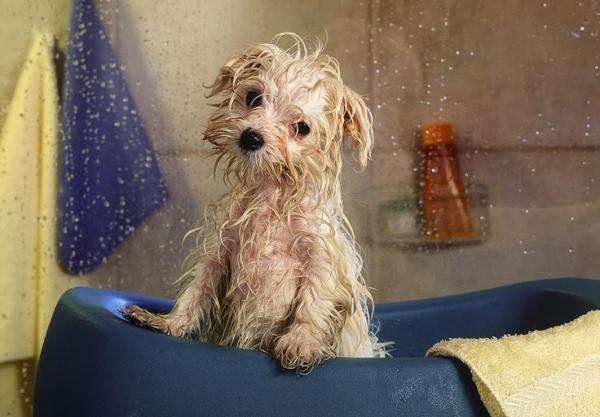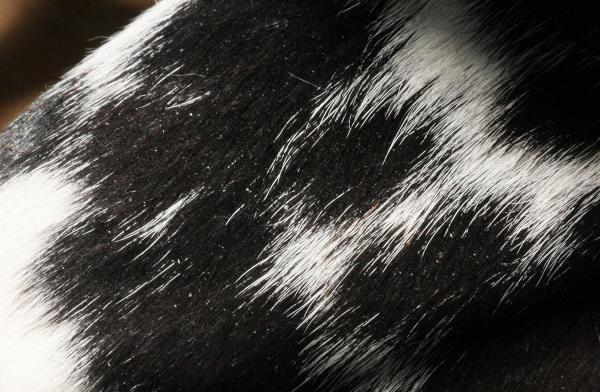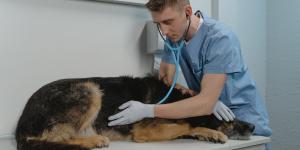What Causes Dandruff on Dogs?



See files for Dogs
Some guardians wonder if it is possible for dogs to get dandruff. Although its exact cause is poorly understood, dandruff is a condition whereby dead skin cells accumulate on and around hair. Humans get dandruff on their scalp due the greater number of sebaceous glands which mix with the dead skin cells and the ability of the hair to collect the dandruff. With this in mind, we can see that dogs not only can get dandruff, but they often get it more extensively due to the greater number of sebaceous glands on their body. While dandruff isn't a serious health condition, it can be a hygiene issue and many guardians will want to do something about it. AnimalWised explains the causes and treatment of dog dandruff by asking what causes dandruff on dogs?
What is dandruff in dogs?
As mentioned in the introduction, dandruff is the peeling of skin cells which then appear on the dog's coat. This appearance is in the form of white flakes, although it is usually composed of more than the skin cells itself. It may also contain sebum, dirt and microorganisms such as yeast. The latter can be related to the cause of the dandruff, but not always.
While we do know about contributing factors, there is no conclusive understanding to the exact cause of dandruff. There may be other health alterations which contribute to its production. These can be of varying seriousness and will be concurrent with other symptoms, depending on their underlying cause.
While dandruff is common, it is important not to confuse it with other skin problems in dogs. For example, excessive sebum production can result in the appearance of dry flakes on a dog's coat. While dandruff is commonly associated with dry skin, excessive sebum production will cause the dog's skin to be oily. This process is known as seborrhea in dogs. This is a disease related to keratin production and requires veterinary consultation.
Another problem to consider is a potential parasitical infestation. An example is a scabies variant from Cheyletiella spp. mites. These mites are sometimes called ‘walking dandruff’ as they appear like moving dandruff flakes. They most commonly affect puppies under three, appearing the most on the neck and back. They ae contagious and can cause itching. Treatment requires deworming and environmental control measures.
Learn about walking dandruff in dogs and other dog diseases which can be transferred to humans in our related article.
Symptoms of dandruff in dogs
The main symptom of dandruff is the appearance of white flakes on the dog's coat. We may notice other symptoms such as scratching more than usual. This is because skin dryness can also result in itching. Excessive scratching can further complicate the problem by damaging the skin by forming redness, swelling, open wounds and scabs. This damage can lead to secondary bacterial infections.
Excessive itching can cause a lot of discomfort and restlessness in the dog. Additionally, this process can cause hair loss and complications when secondary infection occurs. The coat will also be in visibly poor condition and lose its healthy shine.
Learn more about these concurrent symptoms with our article on why a dog has black dandruff and bald spots.

Causes of dandruff in dogs
The exact cause of dandruff in dogs is poorly understood. We do know there are various influencing factors which can result in the appearance of dandruff. Milder cases are usually related to management problems, such as providing the dog with an inadequate diet or bathing them with products that are not suitable for canines.
The most serious causes of dog dandruff are in the form of pathologies that require veterinary treatment. To know how to remove dandruff in dogs, the underlying cause must first be identified. The following are the most common causes of dandruff in dogs:
- Hygiene problems: poor hygiene in the home or with the dog themselves can influence the generation of dandruff. These problems can manifest from neglect, but they can also occur when improper hygiene measures are implemented such as the use of inappropriate shampoos when bathing a dog.
- Incorrect diet: our dog's diet must provide them with all the nutrients they need to maintain their health. While there are general nutritional needs in dogs, each individual will have their specific dietary requirements which must be met. Dandruff and poor coat condition can be indicators of nutritional issues.
- Weather conditions: cold temperatures and lack of humidity can dry out the skin. When this occurs, the skin cells can flake and peel off more easily.
- Diseases: there are various pathologies that can influence dandruff production and poor coat condition in dogs. Dogs will typically also present other clinical signs symptomatic of the specific disease. An example is hypothyroidism in dogs, a condition which can lower the immune system. In these cases, veterinary diagnosis is essential to determine the correct corresponding treatment.
How to treat dandruff in dogs
Getting rid of a dog's dandruff is not always easy, especially when an underlying cause cannot be determined. The first thing we will have to do is assess their environment and care. If we know the dog's hygiene is not being met correctly, we need to do so immediately. For example, we can look at the state of their bed on which they sleep to see if it has been cleaned recently.
We need to look at their diet and determine whether it is meeting the dog's nutritional needs. The best diet for dogs is one that is tailored according to individual factors such as age and health status. We need to also analyze any products we use on their coat, whether commercial or home treatments.
While bathing correctly can get rid of the dog's dandruff temporarily, it will not necessarily address the underlying cause. For example, if there is an infestation of parasites, the dog will require an appropriate deworming treatment prescribed by the veterinarian.
If the dog's dandruff is persistent or accompanied by other symptoms, it is vital you take them to a veterinarian. They will be able to run the correct diagnostic tests to determine the underling cause and provide the correct corresponding treatment.
Can you use dandruff shampoo on dogs?
If the question is whether you can use human shampoo such as Head & Shoulders on a dog with dandruff, the answer is no. These shampoos are specially formulated to meet the needs of people with dandruff, corresponding to the pH of the skin and containing ingredients which are beneficial for humans. Dogs have different needs when it comes to their skin and coat. Using inappropriate treatments can do more harm than good and even encourage issues such as dandruff.
Fortunately, you can purchase medicated shampoos which are specially formulated for use on dogs with dandruff. Not all are of equal quality, so you will have to do some research on the best for your dog. Ideally, you should ask a qualified veterinarian for their recommendation.
While there are home remedies for dandruff in dogs, we need to be careful with their use on dogs. Many of the natural compounds suggested as dandruff treatment can be either ineffective or even harmful to the dog. An example is various essential oils which are used topically, but which can have compounds from plants that are toxic to dogs.

How to prevent dandruff in dogs
Taking into account the causes that can result in dandruff on dogs, we can look at some of the ways we can prevent dandruff developing in the first place:
- Take care of your dog's hygiene: do so according to the characteristics of their coat and their specific lifestyle. Brush them regularly and bathe only when necessary, making sure to rinse off any soap residue after lathering them.
- Dog hygiene products: only use products which have been specifically formulated for dogs. If you have doubts about which ones are suitable for your dog, consult your veterinarian or dog groomer.
- Nutrition: provide a quality diet according to their life stage, health status and other pertinent characteristics. This diet should be based on protein of animal origin. A good supply of omega 3 and omega 6 fatty acids is known to be beneficial for the skin and hair. The amounts your dog needs should be found in their regular feed without the need for supplements. Only take supplements for dogs if advised to do so by your veterinarian.
- Regular vet visits: if the dandruff does not subside even after providing a good diet and ensuring the right care for their hygiene, you will need to speak to a veterinarian. They will be able to determine the underlying cause. Regularly veterinary checkups help use to catch a problem earlier and better ensure a good prognosis.
Learn more about the influence of yeast in dandruff on dogs with our article on the causes and treatment of Malassezia in dogs.

This article is purely informative. AnimalWised does not have the authority to prescribe any veterinary treatment or create a diagnosis. We invite you to take your pet to the veterinarian if they are suffering from any condition or pain.
If you want to read similar articles to What Causes Dandruff on Dogs?, we recommend you visit our Skin problems category.
- Carlson, & Giffin. (2002). Practical manual of canine veterinary medicine. Madrid. Editorial Drac.
- Dlujnewsky, J. (2018). The nutrients that the skin needs. Ateuves Magazine, 57, 14-16.







